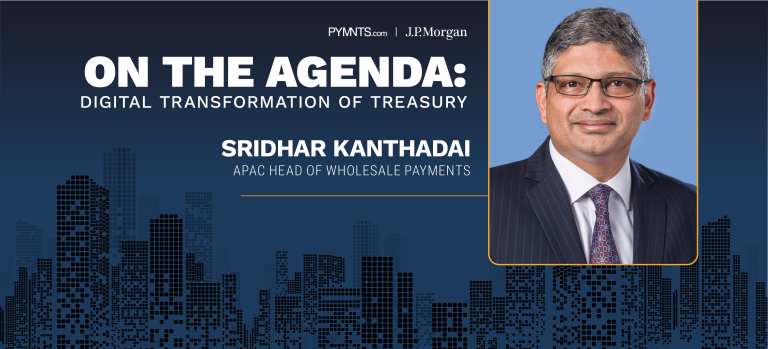
The great digital shift has exposed some glaring inefficiencies in corporate back offices. Treasury departments need to modernize as they grapple with the pandemic — streamlining the way cash is handled, how strategic decisions about cash flow are crafted and how payments are made.
The trend is away from paper, but true digitization does not stop there.
According to Sridhar Kanthadai, APAC head of wholesale payments at J.P. Morgan, the successful treasury transformation in the Asia Pacific region hinges on digitization — and not simply electronification.
“Quite often, we think about digitization and we use that as a proxy for simple electronification,” Kanthadai told Karen Webster in an interview. There’s a difference, one that transcends simply rendering documents into data files.
Corporates must look at the entire set of processes that govern operations, whether with their own clients or suppliers and with banking partners in the middle, he said.
“The way we think about digitization is in a more holistic fashion, whether it’s the onboarding of clients, whether it’s the connectivity with clients, whether it’s the transaction management with clients, or even the servicing piece,” Kanthadai said, adding that due to the coronavirus, clients have become more accepting that there is an opportunity to digitize every part of this “value chain.”
This is certainly true in Asia Pacific, where the pandemic has sped up digitization to a relatively greater degree than other parts of the world.
Kanthadai referenced a recent joint white paper published by Eurofinance and J.P. Morgan that surveyed treasury professionals across the globe, which found roughly 70 percent of firms in APAC accelerated their own “digital journeys” and transformations. That is higher than the percentages registered in other regions such as Europe, the Middle East and Africa (EMEA) and Latin America, where rates have been in the 50-plus percent levels.
The legacy of manual payment modes is one factor behind the acceleration. The use of physical checks for payment, for example, remains prevalent in markets like India, Thailand and Malaysia, and the movement restrictions during the pandemic meant “there was a crisis for our clients in terms of being able to collect payments,” said Kanthadai.
Another factor is the regulatory requirements in many markets that historically necessitate paper documentation for cross-border movements of funds. “The pandemic provided us greater opportunity to work with regulators to create digital solutions,” said Kanthadai.
“We have a number of solutions across markets, such as India, Southeast Asia and China, where cross-border payments have been brought down to effectively automated interactions that do two things: removing the need for paper as well as the ability to connect to customs and regulatory databases, both in a fully compliant manner,” he added.
Digital Natives Versus Brick-And-Mortar
Helping clients prioritize digitization would depend on where the company is in the journey.
“There are digital-native companies, especially in areas like eCommerce, where their ability to continue to stay in business primarily because they were digital has enabled them to take faster leadership in that space,” Kanthadai said.
But challenges, along with opportunities, lie ahead for companies that are more traditional than their digital brethren, because of the manual and physical processes they have to overcome, and “had to in some ways think out of the box to see how they could continue to stay in business,” he said.
Beyond simply rendering information into bits and bytes, he said the purpose of digitization also revolves around understanding the trends being conveyed by that data. Digitization efforts are being debated at a much more senior level, where treasurers are becoming more strategic in their outlook toward using data for cash flow forecasting and liquidity management.
“This has historically been on the dashboard of the treasurers, but there’s been a lot of effort to just get data as opposed to having time for analysis,” he said.
The real challenge for treasurers is to take all of this digitization that now creates real-time data and availability of that data and make better decisions for the company as a whole.
What’s Next
Looking ahead, Kanthadai said there is a clear move toward a more eCommerce style or “direct-to-consumer opportunities,” which would challenge business models.
Businesses today “deal with dealers, distributors or other kinds of intermediaries. So moving from that directly to consumers has a pretty significant impact on the way their sales, payment, collection and reconciliation processes work,” he said.
Kanthadai said the bank is investing not just in the payment-to-suppliers process but also how payment is collected from consumers, or the merchant acquiring space, which is traditionally the area of focus for FinTechs. “We’re expanding our program in Asia Pacific, where there are also unique opportunities with the growth of real-time and eWallet payments,” he said.
With a nod to digitization in the APAC region, he said, “What the pandemic has really created is an opportunity for everybody to move much faster than they would otherwise have done.”